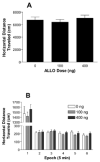Allopregnanolone influences the consummatory processes that govern ethanol drinking in C57BL/6J mice
- PMID: 17376546
- PMCID: PMC1906740
- DOI: 10.1016/j.bbr.2007.02.028
Allopregnanolone influences the consummatory processes that govern ethanol drinking in C57BL/6J mice
Abstract
Although systemic allopregnanolone (ALLO; a positive modulator of GABA(A) receptors) has been shown to enhance ethanol-reinforced responding and to modulate drinking patterns in rodents, the effects of centrally administered ALLO on ethanol intake are not known. The current work examined the effects of intracranial ALLO on operant ethanol self-administration in food- and water-satiated mice, with a procedure designed to estimate ALLO's influence on appetitive versus consummatory processes. Male C57BL/6J (B6) mice were trained to press an ethanol-appropriate lever by being reinforced with 30-min of continuous access to a 10% ethanol solution. Following surgical implantation of a guide cannula aimed at the lateral ventricle and subsequent habituation to vehicle infusions, ALLO (50-400 ng; ICV) was delivered immediately prior to session start. ALLO doses of 100 and 400 ng were further evaluated for their effects on locomotor behavior within activity chambers. ALLO selectively modulated ethanol intake patterns associated with the onset and maintenance of self-administration, while leaving appetitive (i.e., ethanol seeking) measures unaltered. The effects of ALLO on drinking patterns were dissociable from changes in locomotor behavior, as evidenced by the absence of ALLO's influence on response frequency and horizontal distance traveled. These findings support the premise that manipulations in brain ALLO levels may influence the regulatory processes governing ethanol consumption.
Figures



Similar articles
-
Effect of ganaxolone and THIP on operant and limited-access ethanol self-administration.Neuropharmacology. 2012 Sep;63(4):555-64. doi: 10.1016/j.neuropharm.2012.05.007. Epub 2012 May 18. Neuropharmacology. 2012. PMID: 22613838 Free PMC article.
-
Neurosteroid modulators of GABA(A) receptors differentially modulate Ethanol intake patterns in male C57BL/6J mice.Alcohol Clin Exp Res. 2005 Sep;29(9):1630-40. doi: 10.1097/01.alc.0000179413.82308.6b. Alcohol Clin Exp Res. 2005. PMID: 16205363 Free PMC article.
-
Inhibition of 5alpha-reduced steroid biosynthesis impedes acquisition of ethanol drinking in male C57BL/6J mice.Alcohol Clin Exp Res. 2008 Aug;32(8):1408-16. doi: 10.1111/j.1530-0277.2008.00718.x. Epub 2008 Jun 28. Alcohol Clin Exp Res. 2008. PMID: 18565155 Free PMC article.
-
Manipulation of GABAergic steroids: Sex differences in the effects on alcohol drinking- and withdrawal-related behaviors.Horm Behav. 2010 Jan;57(1):12-22. doi: 10.1016/j.yhbeh.2009.07.002. Epub 2009 Jul 15. Horm Behav. 2010. PMID: 19615369 Free PMC article. Review.
-
GABAA Receptor-Modulating Steroids in Relation to Women's Behavioral Health.Curr Psychiatry Rep. 2015 Nov;17(11):92. doi: 10.1007/s11920-015-0627-4. Curr Psychiatry Rep. 2015. PMID: 26396092 Review.
Cited by
-
Effect of ganaxolone and THIP on operant and limited-access ethanol self-administration.Neuropharmacology. 2012 Sep;63(4):555-64. doi: 10.1016/j.neuropharm.2012.05.007. Epub 2012 May 18. Neuropharmacology. 2012. PMID: 22613838 Free PMC article.
-
Local changes in neurosteroid levels in the substantia nigra reticulata and the ventral tegmental area alter chronic ethanol withdrawal severity in male withdrawal seizure-prone mice.Alcohol Clin Exp Res. 2013 May;37(5):784-93. doi: 10.1111/acer.12027. Epub 2012 Dec 20. Alcohol Clin Exp Res. 2013. PMID: 23278716 Free PMC article.
-
Role of acetaldehyde in ethanol-induced elevation of the neuroactive steroid 3alpha-hydroxy-5alpha-pregnan-20-one in rats.Alcohol Clin Exp Res. 2008 Oct;32(10):1774-81. doi: 10.1111/j.1530-0277.2008.00762.x. Epub 2008 Jul 24. Alcohol Clin Exp Res. 2008. PMID: 18652594 Free PMC article.
-
The alcohol deprivation effect in C57BL/6J mice is observed using operant self-administration procedures and is modulated by CRF-1 receptor signaling.Alcohol Clin Exp Res. 2009 Jan;33(1):31-42. doi: 10.1111/j.1530-0277.2008.00808.x. Epub 2008 Oct 18. Alcohol Clin Exp Res. 2009. PMID: 18945225 Free PMC article.
-
Ivermectin reduces alcohol intake and preference in mice.Neuropharmacology. 2012 Aug;63(2):190-201. doi: 10.1016/j.neuropharm.2012.03.014. Epub 2012 Mar 23. Neuropharmacology. 2012. PMID: 22465817 Free PMC article.
References
-
- Andréen L, Sundstrom-Poromaa I, Bixo M, Nyberg S, Backstrom T. Allopregnanolone concentration and mood -- a bimodal association in postmenopausal women treated with oral progesterone. Psychopharmacology. 2006;187:209–21. - PubMed
-
- Belelli D, Lambert JJ. Neurosteroids: endogenous regulators of the GABA(A) receptor. Nat Rev Neurosci. 2005;6:565–75. - PubMed
-
- Bowen CA, Purdy RH, Grant KA. An investigation of endogenous neuroactive steroid-induced modulation of ethanol’s discriminative stimulus effects. Behav Pharmacol. 1999;10:297–311. - PubMed
-
- Czachowski CL, Legg BH, Samson HH. Effects of acamprosate on ethanol-seeking and self-administration in the rat. Alcohol Clin Exp Res. 2001;25:344–50. - PubMed
Publication types
MeSH terms
Substances
Grants and funding
LinkOut - more resources
Full Text Sources
Medical

